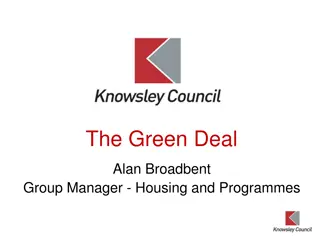Energy Efficiency Services Limited (EESL) Cooling Initiative in India
EESL's initiative in the National Cooling Action Plan aims to address the escalating demand for air conditioning in India while promoting energy efficiency and sustainability. Through programs like the Bulk Procurement Mechanism and the EESL Super Efficient Air Conditioning Programme (ESEAP), EESL is driving the adoption of super-efficient ACs with low global warming potential refrigerants. This market-led approach not only enhances energy efficiency but also mitigates the environmental impact of cooling technologies in the country.
Download Presentation

Please find below an Image/Link to download the presentation.
The content on the website is provided AS IS for your information and personal use only. It may not be sold, licensed, or shared on other websites without obtaining consent from the author.If you encounter any issues during the download, it is possible that the publisher has removed the file from their server.
You are allowed to download the files provided on this website for personal or commercial use, subject to the condition that they are used lawfully. All files are the property of their respective owners.
The content on the website is provided AS IS for your information and personal use only. It may not be sold, licensed, or shared on other websites without obtaining consent from the author.
E N D
Presentation Transcript
EESLs Initiative in National Cooling Action Plan 17 January, 2018
Bulk Procurement Mechanism EESL Super Efficient Air Conditioning Programme (ESEAP)
The Imperative- ACs contribute to peak demand 200 1200 Room AC Peak Load at bus-bar (GW) Peak Demand Contribution by Household Appliances 1000 150 800 100 (W) 600 One AC 400 2 Incandescent Bulbs 50 2 Ceiling Fans 4 Tube lights One TV One Refrigerator 200 0 0 2010 2020 2030 Room AC Other Appliances Studies show that the additional demand from room ACs in India is equivalent to 200-300 large (500 MW) power plants by 2030 i.e. 100-150 GW and 10% of energy demand (~ 300 TWh) This implies Significant addition to the grid generation capacity (read Coal based) OR Investing in in-situ diesel generators or battery inverters Eventually increasing consumer tariffs 3 Environmental Energy Technologies Division Source: Lawrence Berkeley National Lab (LBNL), USA
The Case for Market Side Intervention Policy led rating programme has improved energy efficiency with time Urbanization led rising AC demand (CAGR ~ 15%) Yet Slow inverter technology push (only 20% till date; major markets >75%) Negligible low GWP options (HCFCs like R-290 / R-32/ R-410A/ blends)
ESEAP Offering Customers Want Product Super Efficiency (ISEER 5.2, 1.5 ton) Split configuration Inverter technology 33% efficient from 5 Star Low GWP First Costs & Running Costs Warranty After Sales experience Assurance Comprehensive warranty 3 year; Compressor (5 years) Tested to work in conditions like 52 C, Pollution Easy Financing options Convenience Installation and 3 year annual service by brand Buyback option Financing options
Impact: Aggregation of AC market 100,000 ACs, rated ISEER 5.2 AC1 at rational prices2 with i. 3 year all comprehensive warranty ii. ACs supplied via institutional channels (and not retail) iii. Co-benefits EESLs market led approach to deliver cooling for India, without heating up the planet a) Higher uptake of Low GWP refrigerants (R-410A, R-290) b) Design for India (works even at 52 C, polluted regions) 1: 33% more efficient than the 5-Star rated AC with EER of 3.5 2: nearly 30% discount to expected open market prices
Cost Analysis 3 Star Inverter AC 5 Star Inverter AC Super Efficient Inverter AC Conclusion Drop the idea of purchasing a 5 star rated AC today; ISEER 3.2 4.2 5.2 Electricity Wattage 1650 1250 1015 Market price 40,000 45,000 54,500 Simply purchase EESL super efficient AC. 5 year AMC 20,000 20,000 3000 Annual operating days 225 225 225 Operating Hours per day 10 10 10 Annual Electricity Consumption Units 3000 2275 1850 1. ESEAP AC analysed against 5 star AC- 2014, 2015, (expected) 2018 Annual Electricity Charges @ 8 Rs. 24000 18200 14800 2. Payback time based on expected consumer savings against incremental spend on 5 star product Electricity Charges for 5 years Total Cost for 5 years 1,20,000 91,000 74,000 3. All inclusive price includes installation , warranty and annual service 180K 156K 131K Source: EESL calculations,























